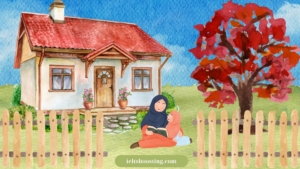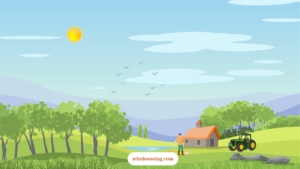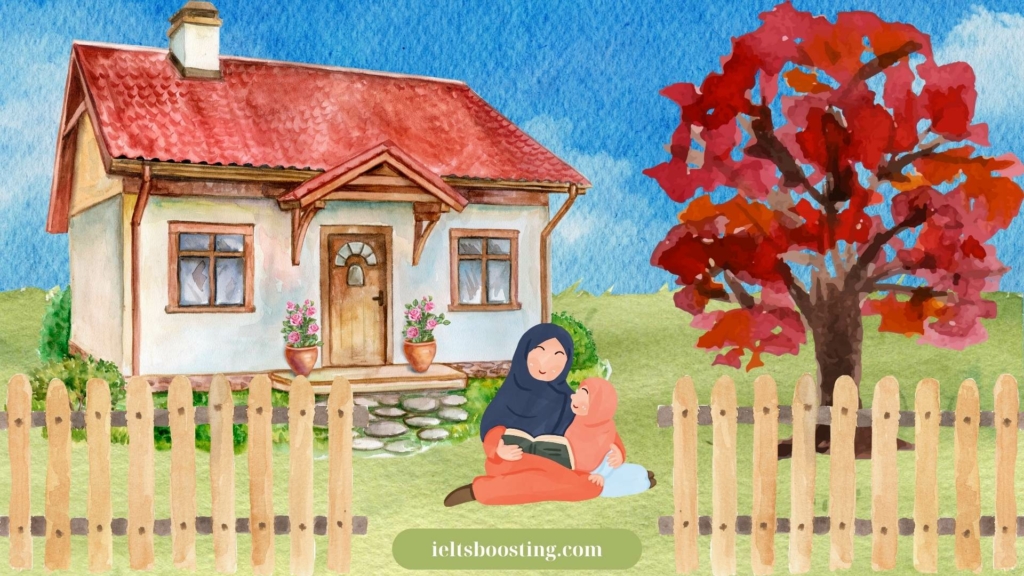Describe an ideal house you would like to have
You should say:
Where it would be
What it is like
What special features it has
And explain why it would be your ideal house

describe an ideal house you would like to have
Sample question for describe an ideal house you would like to have
In an ideal world, my dream house would be nestled near a tranquil lake, surrounded by an abundance of trees, offering a serene and picturesque retreat. This setting would provide ample opportunities for fishing and outdoor exercise in the midst of nature.
The house itself would be a two-story structure, designed with a focus on comfort and convenience. Modern technology would be seamlessly integrated to enhance daily life, offering amenities needed for a comfortable and convenient lifestyle, ranging from a well-equipped kitchen to efficient cooling systems.
One of the most striking features of my dream house would be its large, floor-to-ceiling glass windows. These windows would serve two purposes. Firstly, they would offer breathtaking views of the lake and the surrounding trees, allowing me to feel truly immersed in nature while in the comfort of my home. Secondly, they would flood the living spaces with an abundance of natural light, creating a warm and inviting atmosphere.
While the house would be spacious, I would prefer it not to be overly wide to minimize the time required for cleaning and maintenance.
Now, let me explain why this would be my ideal house. Firstly, the proximity to the lake and the small forest would provide a deep sense of connection to nature. I could spend my leisure hours fishing by the lake and hiking through the woods, activities that are essential for my well-being and offer the perfect escape from the hustle and bustle of urban life.
Moreover, the house’s design, with its modern conveniences and large glass windows, would allow me to live in harmony with the environment while enjoying the comforts of contemporary living. It strikes a balance between the serenity of the natural world and the convenience of modern technology.
In conclusion, my dream house by the lake, surrounded by trees, represents the perfect blend of relaxation, a profound connection to nature, and modern living. It’s a place where I could truly unwind, find inspiration, and live in harmony with the beauty of the natural world.
Advanced vocabulary
- Nestled (verb) – nằm kín đáo: Located in a secure or comfortable position.
- Tranquil (adj) – yên bình: Calm and peaceful.
- Picturesque (adj) – đẹp như tranh vẽ: Visually attractive, especially in a quaint or charming way.
- Serene (adj) – thanh bình: Calm, peaceful, and untroubled.
- Retreat (noun) – nơi ẩn náu: A place of refuge, seclusion, or privacy.
- Seamlessly (adv) – một cách liền mạch: Smoothly and continuously, with no apparent gaps or spaces between one part and the next.
- Amenities (noun) – tiện nghi: Desirable or useful features or facilities of a building or place.
- Breathtaking (adj) – làm nghẹt thở: Astonishing or awe-inspiring in quality, so as to take one’s breath away.
- Immersed (verb) – đắm chìm: Deeply involved in a particular activity or interest.
- Harmony (noun) – hài hòa: A consistent, orderly, or pleasing arrangement of parts; congruity.
- Unwind (verb) – thư giãn: Relax after a period of work or tension.
- Inspiration (noun) – nguồn cảm hứng: The process of being mentally stimulated to do or feel something, especially something creative.
- Contemporary (adj) – hiện đại: Belonging to or occurring in the present.
- Sustainability (noun) – bền vững: The ability to be maintained at a certain rate or level.
- Eco-friendly (adj) – thân thiện với môi trường: Not harmful to the environment.

describe an ideal house you would like to have
You may be interested in : Describe a photo that makes you feel happy
Part 3 – describe an ideal house you would like to have
What are the most common architectural styles in Vietnamese cities?
In Vietnamese cities, you’ll encounter a diverse array of architectural styles that mirror the nation’s rich history. Among the most common ones is the influence of French colonial architecture, which is particularly conspicuous in the majestic buildings and historic villas dating back to the colonial era, especially in Hanoi and Ho Chi Minh City. Additionally, traditional Vietnamese architecture plays a prominent role, with its intricate wooden designs and distinctive pagoda-style roofs frequently seen in historical areas and temples. In contemporary times, there’s a growing prevalence of modern architecture marked by sleek designs and glass facades, symbolizing Vietnam’s rapid economic growth. Together, these architectural styles showcase Vietnam’s cultural evolution while preserving its unique heritage.
- Majestic (Adj) – Nguy nga: Having impressive grandeur or dignity.
- Conspicuous (Adj) – Dễ thấy: Easily noticeable or prominent.
- Intricate (Adj) – Phức tạp: Highly detailed and complex, often with delicate or complicated patterns.
- Prominent (Adj) – Nổi bật: Standing out and easily seen or recognized.
- Cultural evolution (N) – Tiến hóa văn hóa: The gradual development and transformation of a society’s cultural practices and beliefs.
- Rapid economic growth (N) – Tăng trưởng kinh tế nhanh chóng: Swift and substantial expansion of the economy.
- Colonial era (N) – Thời đại thuộc địa: A historical period when a country was under the control of a foreign colonial power.
- Adaptation (N) – Sự thích nghi: The process of adjusting to new conditions or influences.
- Architectural heritage (N) – Di sản kiến trúc: The historical and cultural legacy of architectural achievements.
- Contemporary design (N) – Thiết kế đương đại: Modern and up-to-date approaches to architectural planning and style.
What’s the difference between an apartment and a house?
What’s the difference between living in the countryside and living in the city?
Living in the countryside typically offers a peaceful, quiet environment with natural surroundings and space for outdoor activities. It often means a closer-knit community but can also mean fewer amenities and longer distances to travel for shopping, education, and healthcare.
In contrast, living in the city usually provides easy access to a wide range of amenities, such as diverse restaurants, entertainment options, and specialized services. Cities tend to have more job opportunities and better access to education and healthcare. However, this comes with the downsides of noise, pollution, and often a faster-paced, more stressful lifestyle. Cities are also more densely populated, leading to less personal space and smaller living quarters compared to the countryside.
- Rural serenity (N) – Bình yên nông thôn: The peaceful and calm atmosphere often found in the countryside.
- Natural surroundings (N) – Môi trường tự nhiên: The environment consisting primarily of nature, such as trees, fields, and lakes, typically found in the countryside.
- Closer-knit community (N) – Cộng đồng khăng khít: A social structure in the countryside where relationships are close and community bonds are strong.
- Urban amenities (N) – Tiện nghi đô thị: The various facilities and services such as shops, restaurants, and entertainment centers available in a city.
- Densely populated (ADJ) – Dân cư đông đúc: Describing an area with a high population density, typically found in cities.
- Noise pollution (N) – Ô nhiễm tiếng ồn: The harmful or annoying levels of noise in an environment, a common issue in urban areas.
- Fast-paced lifestyle (N) – Lối sống nhanh nhẹn: A way of living where activities and life move quickly, often associated with urban living.
- Commute distances (N) – Khoảng cách di chuyển: The length one must travel from home to work or other destinations, often longer in rural areas.
- Cultural hub (N) – Trung tâm văn hóa: A focal point for cultural activities, such as theaters and museums, commonly found in cities.
What are the advantages of the facilities of the apartment and the facilities of the house?
Apartment facilities typically include conveniences like maintenance and security, allowing for a more carefree living experience, as well as amenities such as gyms and pools that promote a communal lifestyle. Houses, however, offer the benefit of private spaces, such as personal yards, which cater to family activities and personal hobbies. Home facilities often allow for greater customization and expansion, giving homeowners the freedom to alter their living space to suit their tastes. Moreover, houses can serve as a long-term investment, with the potential for property value appreciation over time.
- Conveniences (N) – Tiện nghi: The quality of being suitable to one’s comfort, purposes, or needs.
- Carefree (ADJ) – Không lo âu: Free from anxiety or responsibility.
- Amenities (N) – Tiện ích: Desirable or useful features or facilities of a building or place.
- Communal lifestyle (N) – Lối sống cộng đồng: A way of living where people share resources and spaces. Private spaces (N) – Không gian riêng tư: Areas of a property that are exclusively used by the owner or resident.
- Customization (N) – Sự cá nhân hóa: The action of modifying something to suit a particular individual or task.
- Expansion (N) – Sự mở rộng: The action of becoming larger or more extensive.
- Long-term investment (N) – Đầu tư dài hạn: An investment that a person or entity holds for an extended period, typically several years.
- Property value appreciation (N) – Sự gia tăng giá trị tài sản: An increase in the worth of a property over time.5. What difficulties do people have living in the city?

describe an ideal house you would like to have
What can be done to reduce the stress of city life?
To alleviate the stress of city life, individuals can engage in regular physical activities, such as joining a gym or participating in community sports, which promote mental well-being. Additionally, making time for social interactions and community-building activities can provide emotional support and a sense of belonging. For example, a city dweller might join a local yoga class which not only offers a regular exercise routine but also the opportunity to meet and connect with neighbors, creating a network of support
- Alleviate (V) – Giảm bớt: To make (suffering, deficiency, or a problem) less severe.
- Engage in (V) – Tham gia: To participate or become involved in.
- Physical activities (N) – Hoạt động thể chất: Forms of exercise or movements that increase heart rate and improve physical fitness.
- Mental well-being (N) – Sức khỏe tinh thần: A state of comfort, health, or happiness in one’s psychological state.
- Social interactions (N) – Tương tác xã hội: The exchanges between people that can affect the way they think or behave.
- Community-building (N) – Xây dựng cộng đồng: Activities or actions that strengthen and enhance the relationships within a community.
- Emotional support (N) – Sự hỗ trợ tinh thần: Assistance that gives a person a feeling of security and care, often through companionship or empathy.
- Sense of belonging (N) – Cảm giác thuộc về: The feeling of being connected and accepted within a group or community.
- Yoga class (N) – Lớp yoga: A guided session of yoga practice, often involving a series of postures and breathing exercises.
- Exercise routine (N) – Thói quen tập luyện: A regular schedule of physical activities designed to improve or maintain physical fitness.
- Network of support (N) – Mạng lưới hỗ trợ: A system of individuals or groups that provide assistance and encouragement to one another.


